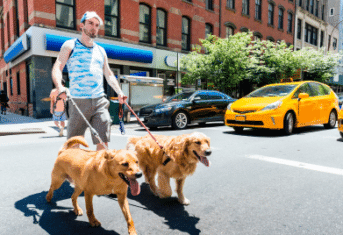Summer Travel with Your Pet Made Easy

Summer Travel with Your Pet Made Easy
To quote George Gershwin, “Summertime and the livin’ is easy,” but travelin’ with your pet requires more than just hopping in the car with your furry family member and heading off on a road trip. Here are some tips about travel for the pet-owning family.
Which pets should travel?
Travel is not for every pet. If you are going to be gone only a few days or less, it maybe better for your pet to stay home with a pet sitter, especially if you have a large dog and the trip involves air travel as cargo. (Read more on air travel in the “How to get there” section.) Geriatric animals may not be the best travelers either. Just like grandma, changes in schedule, water and nap time may not be the older pet’s idea of fun. Pets with chronic health conditions such as kidney disease or heart disease may decompensate from travel stress, so check with your veterinarian about the feasibility of traveling with your older pet.
How to get there
Pet owners are limited to travel by car or airplane since long distance trains and buses typically do not allow pets. Local buses and trains may allow small pets if they are confined in a carrier.
Car – If you are traveling by car, your pet needs to be restrained to protect your pet if you stop quickly and to protect you from being distracted by their antics. Seatbelts can attach to a special harness or you can use the existing seatbelts to curtail any movements of the pet carrier during quick stops.
Air – An excellent resource for the pet owner planning an airline trip is PetFlight.com. This site has travel tips, airline information and travel alerts. Each airline has its own rules about pets on flights, so be sure to check with your carrier well before your planned trip. Make sure your pet and its carrier meet the airline’ regulations, and you have the appropriate travel certificate from your veterinarian.
New to the world of pet travel is Pet Airways the only airline focused on transporting your pet as a passenger, not as cargo. The airline launched July 14, with flights between New York, Denver, Los Angles, Chicago and Washington, D.C.
What to pack
Although bulky, taking your pet’s regular food is likely to prevent a serious case of stomach upset and save you from having to find an emergency clinic and a new source of your pet’s regular food. Abrupt changes in food often set off a bout of vomiting and diarrhea. Litter is bulky too, but a necessity if you are traveling with a cat. Be sure to carry a copy of your pet’s most recent vaccinations. If your pet has health problems, ask your veterinarian for a summary letter explaining your pet’s condition in case you need veterinary care when your regular veterinarian’s office is closed. Be sure the letter lists your pet’s current prescriptions and most recent blood test results.
In addition to packing your pet’s medical information and food and bowls, you need to pack a leash/harness/collar and a backup set all with current ID tags. If your pet has not been microchipped, have your veterinarian implant one so your pet can be identified if it slips its collar.
If you will be staying in one location for more than a week, you might want to ask your veterinarian for a recommendation of a veterinarian in that area. You could also identify a veterinarian using the American Animal Hospital Association’s accredited hospital locator. Finding a veterinarian in advance will save time in an emergency.
Where to stay: finding a pet friendly hotel
The American Automobile Association has an advanced hotel option which allows you to search for hotels which allow pets. The website DogFriendly.com is also a good resource for all things dog friendly. If national parks are your destination this year, the website www.nps.gov can serve as your resource guide for parks and park lodging friendly to your pet.
Always follow good “petiquette” when staying in hotels with your pet. Cover the furniture with a sheet or blanket to protect it from hair. Crate your pet if you leave it alone in the hotel room while dining out and put the “do not disturb” sign on the door so hotel staff will not inadvertently open the door and let your pet escape. When walking your pet, keep away from the building and be sure to pack enough plastic bags to properly dispose of waste. Cats present a different set of problems in a hotel room. Picture yourself trying to get your “scaredy” cat out from underneath the hotel bed. Cats might be better confined in the hotel bathroom or in their travel crate.
While traveling with a pet may present some challenges, being well prepared can help to alleviate stress on you and your pet.
______________________________
For nearly a century, The Animal Medical Center has been a national leader in animal health care, known for its expertise, innovation and success in providing routine, specialty and emergency medical care for companion animals. Thanks in part to the enduring generosity of donors, The AMC is also known for its outstanding teaching, research and compassionate community funds. Please help us to continue these efforts. Send your contribution to: The Animal Medical Center 510 East 62nd Street, New York, NY 10065. For more information, visit www.amcny.org.


































